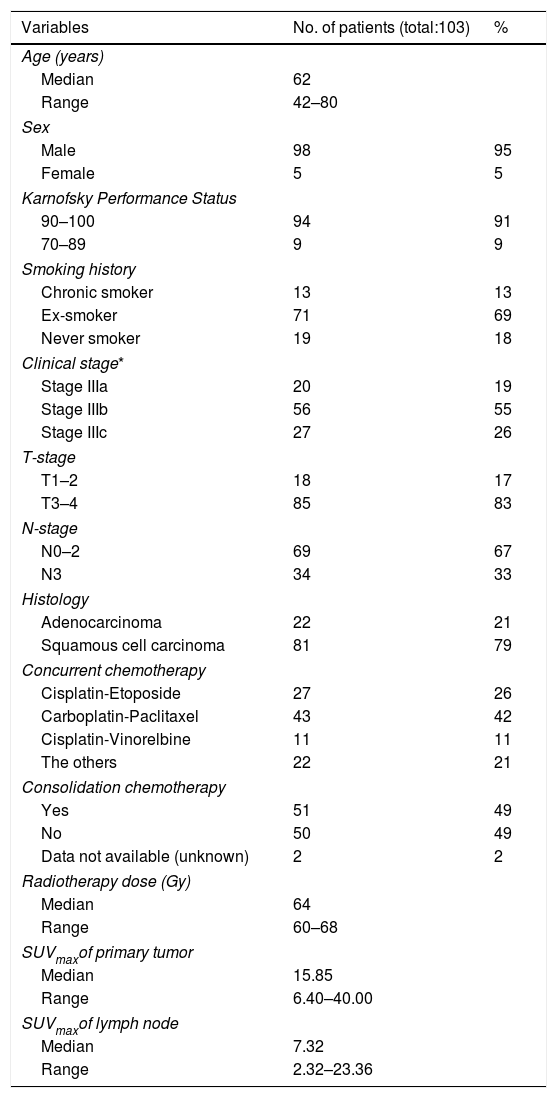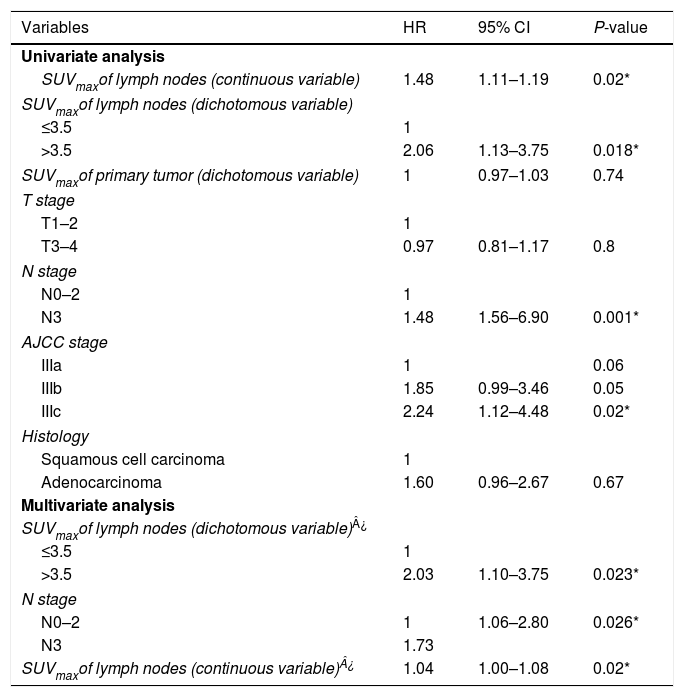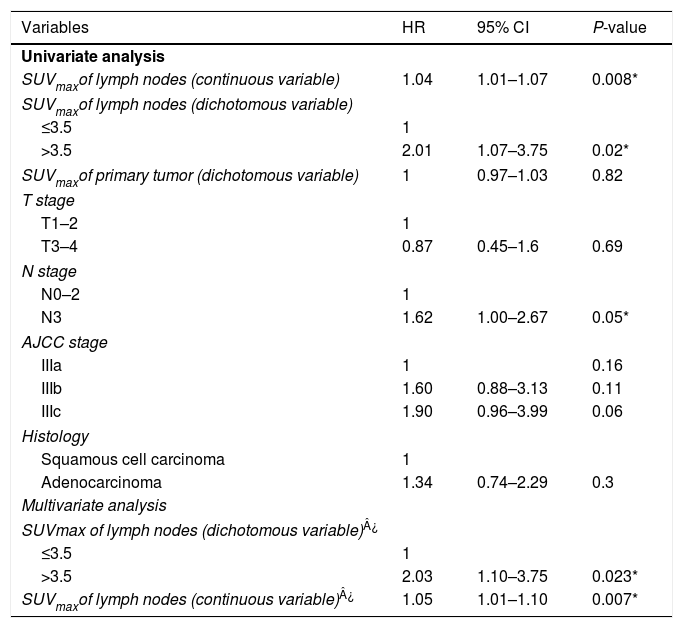Survival heterogeneity exists among patients with non-small cell lung cancer (NSCLC), even within the same stage. We aimed to evaluate the prognostic role of pre-treatment maximum standardized uptake value (SUVmax) in patients treated with definitive concurrent chemoradiotherapy for stage III NSCLC.
Materials and methodsBetween 2010 and 2017, 103 patients with stage III NSCLC who underwent 18F-FDG PET/CT at the time of diagnosis were included in the study.
ResultsHigher tumor stages were correlated with higher pre-treatment SUVmax of lymph nodes (LNs) (p=0.005) but were not correlated with higher SUVmax of primary tumor (PT) (p=0.2). The median SUVmax of LNs was 2.84, 8.06, and 11.11 in stage IIIa, IIIb and IIIc, respectively. Higher nodal stage was also correlated with higher SUVmax of LNs (p=0.01). According to ROC analysis, there was no significant cut-off value of SUVmax observed for PT, therefore continuous variables were used for survival analyses. The best SUVmax cut-off was ‘3.5’ for the LNs, therefore the SUVmax of LNs was evaluated as both a dichotomous and a continuous variable. Pre-treatment SUVmax of PT did not predict survival outcomes but both the continuous and dichotomous variables of SUVmax of LNs predicted RFS and OS. Nodal stage (N0–2 vs N3) and AJCC stage (IIIa vs IIIb vs IIIc) were the other prognostic factors.
ConclusionsPre-treatment SUVmax of LNs had prognostic value in patients treated with definitive concurrent chemoradiotherapy for stage III NSCLC. In future trials, pre-treatment SUVmax of the LNs would serve as a guide for patients who might benefit from more aggressive treatments.
Existe heterogeneidad en la supervivencia entre los pacientes con cáncer de pulmón de células no pequeñas (NSCLC), aun dentro del mismo estadio. Nuestro objetivo fue evaluar el papel pronóstico del máximo valor de captación estandarizado pre-tratamiento (SUVmax) en pacientes tratados con quimio-radioterapia concurrente definitiva para NSCLC estadio III.
Materiales y métodosEntre 2010 y 2017, se incluyó en el estudio a 103 pacientes con NSCLC estadio III sometidos a PET/TC con 18F-FDG en el momento del diagnóstico.
ResultadosLos estadios tumorales superiores se correlacionaron con el SUVmax pre-tratamiento de los ganglios linfáticos (GL) (p=0,005), pero no guardaron relación con el SUVmax del tumor primario (TP) (p=0,2). El SUVmax medio de los ganglios linfáticos fue de 2,84, 8,06, y 11,11 en los estadios IIIa, IIIb y IIIc, respectivamente. Los estadios nodales superiores se correlacionaron también con un SUVmax superior de los ganglios linfáticos (p=0,01). Con arreglo al análisis ROC, no se observó ningún valor de corte significativo de SUVmax para el TP, por lo que las variables continuas se utilizaron para los análisis de supervivencia. El mejor punto de corte para SUVmax fue de ‘3,5’ para los ganglios linfáticos, por lo que el SUVmax de los mismos se evaluó como variable dicotómica y continua. El SUVmax pre-tratamiento del TP no predijo los resultados de supervivencia, pero tanto las variables dicotómica y continua de SUVmax de los ganglios linfáticos predijeron la supervivencia libre de recurrencia (SLR) y la supervivencia global (SG). El estadio nodal (N0-2 vs N3) y la estadificación de la AJCC (IIIa vs IIIb vs IIIc) constituyeron el resto de factores pronósticos.
ConclusionesEl SUVmax pre-tratamiento de los ganglios linfáticos tuvo un valor pronóstico en los pacientes tratados con quimio-radioterapia concurrente definitiva para el NSCLC en estadio III. En ensayos futuros, el SUVmax pre-tratamiento de los GL podría servir de guía a los pacientes que pudieran utilizar tratamientos más agresivos.
Article

Revista Española de Medicina Nuclear e Imagen Molecular (English Edition)










